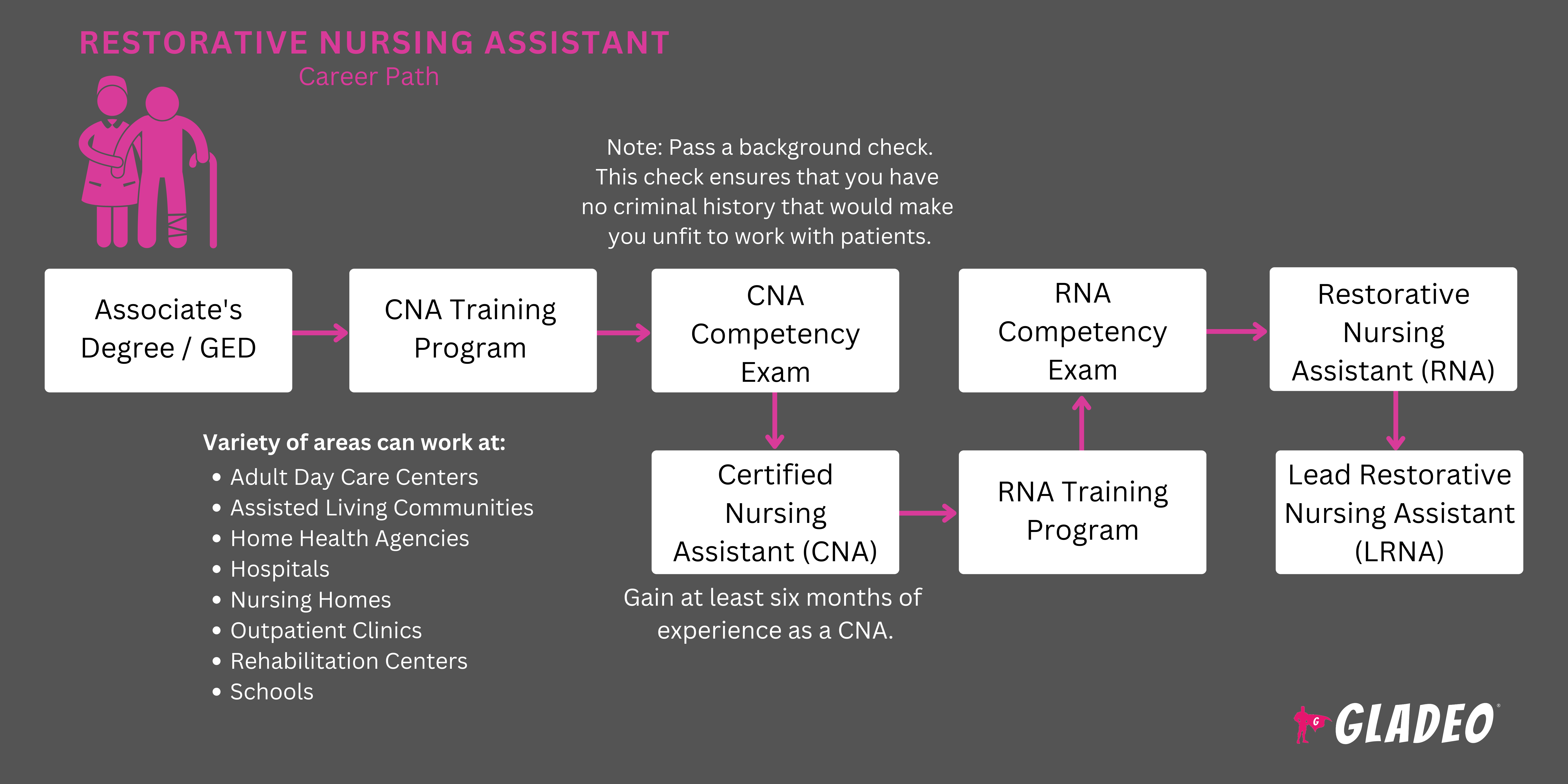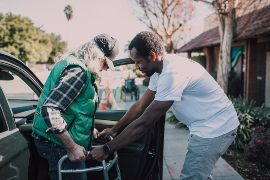Reflektory
Certified Medication Aide (CMA), Certified Nurse Aide (CNA), Certified Nurses Aide (CNA), Certified Nursing Assistant (CNA), Licensed Nursing Assistant (LNA), Nurses' Aide, Nursing Aide, Nursing Assistant, Patient Care Assistant (PCA), State Tested Nursing Assistant (STNA).
After a serious injury or long illness, patients often lose strength, coordination, and cognitive function and need help getting back to their normal lives. That’s where Restorative Nursing Assistants (RNAs) come into play!
RNAs specialize in restorative therapeutic care, assisting recovering patients to regain physical and cognitive capabilities through mobility exercises and activities. They work in a range of long-term settings, such as nursing homes and rehabilitation centers, performing tasks under the guidance of licensed nurses and therapists.
RNAs follow their patient’s rehabilitation plans, ensure patient safety and comfort, monitor and document progress, and communicate with the rest of the healthcare team so that plans can be adjusted, as needed. Their important work contributes greatly to the well-being of patients who are seeking to regain as much independence as possible.
- Wpływ na zdrowie, długość życia i codzienną jakość życia pacjentów
- Helping patients regain independence to perform daily tasks
- Rosnący popyt w sektorze opieki zdrowotnej
- Liczne możliwości rozwoju osobistego i zawodowego
Working Schedule
Restorative Nursing Assistants may work part-time or full-time. Shifts may include nights, weekends, or holidays.
Typical Duties
“An RNA is an advanced CNA [Certified Nursing Assistant],” writes Indeed. Thus there can be some overlap of duties between the two professions, depending on the setting and situation.
- Assist with therapeutic range-of-motion exercises, ambulation training, and other activities prescribed by physical or occupational therapists
- Support patients with personal hygiene (i.e., bathing, grooming, using the toilet) and dressing as they work toward independence and rehabilitation goals
- Serve meals and help patients eat, paying attention to the dietary needs of their care plan
- Help patients transfer between beds and wheelchairs. Assist with walking and repositioning for comfort and therapeutic benefit
- Monitor, record, and track patients’ progress in activities and exercises, noting changes in abilities or conditions
- Report any patient condition changes to the supervising nurse for appropriate action
- Provide companionship, support, and encouragement to patients working on restorative activities
- Document responses to restorative treatments, exercise progress, and health concerns
- Ensure effective communication between patients and healthcare professionals, including physical and occupational therapists, to ensure a cohesive approach to care
- Advocate for patient needs and preferences
- Suggest resources to learn more about nutrition and safety so patients can live healthier lives after being discharged
- If trained and authorized, RNAs may also:
- Pomoc przy nieinwazyjnych procedurach medycznych, takich jak opatrywanie ran.
- Remind patients to take prescribed medications
- Assist with the collection of urine or stool samples
- Transport pacjentów na wizyty
Dodatkowe obowiązki
- Assist with training new RNAs, sharing knowledge and techniques specific to restorative care
- Help set up and maintain equipment used for restorative exercises and activities
- Participate in interdisciplinary team meetings to discuss and plan patient care
- Pomoc w praniu, załatwianiu spraw i planowaniu spotkań
- Pomoc przy wypisywaniu pacjentów
Umiejętności miękkie
- Sposób postępowania przy łóżku
- Współczucie
- Uspokojenie
- Niezawodność
- Zorientowanie na szczegóły
- Odporność emocjonalna
- Empatia
- Integralność
- Umiejętności interpersonalne
- Obserwator
- Cierpliwość
- Wytrzymałość fizyczna
- Budowanie relacji
- Niezawodność
- Świadomy bezpieczeństwa
- Rozsądny osąd
- Silne umiejętności komunikacyjne
- Praca zespołowa i współpraca
Umiejętności techniczne
- Knowledge of rehabilitation and restorative care techniques (i.e., exercises, mobility assistance, cognitive activities, etc.)
- Understanding how to encourage independence during rehabilitation
- Familiarity with hygiene, sterilization practices, and infection control in rehabilitation or long-term care settings
- Proficiency in using/maintaining equipment for restorative care
- Expertise in documenting and maintaining patient records
- Knowledge of common medical conditions in long-term care/rehabilitation settings
- Understanding the roles of rehabilitation professionals such as physical and occupational therapists
- Acute care hospitals
- Placówki dla osób z chorobą Alzheimera
- Ośrodki opieki nad osobami starszymi
- Społecznościowe ośrodki opieki dziennej dla dorosłych
- Społeczności emerytalne zapewniające stałą opiekę
- Rządowe i społeczne agencje zdrowia
- Placówki opieki hospicyjnej
- Szpitalne oddziały rehabilitacyjne
- Placówki opieki pielęgniarskiej (wykwalifikowane placówki opieki pielęgniarskiej)
- Domy opieki i placówki opieki długoterminowej
- Ośrodki ambulatoryjne
- Ośrodki rehabilitacyjne
- Specialized care facilities
- Therapy departments
Restorative Nursing Assistants play a crucial role in the rehabilitation and ongoing care of patients facing challenges due to age, disability, or chronic conditions. RNAs help implement and monitor tailored restorative care plans, sometimes for multiple patients each day. This requires excellent organizational and prioritization skills, along with diligent record-keeping.
Assisting patients with mobility and therapeutic exercises can be physically demanding. Meanwhile, daily interactions with recovering or ill patients can be stressful and emotionally taxing at times. Thus, resilience, patience, and empathy are always necessary.
RNAs frequently work night, weekend, and holiday shifts, requiring adaptability and a flexible schedule. They must also find time to decompress and manage appropriate self-care to maintain their own mental and physical well-being and avoid burnout.
The healthcare sector, especially in long-term and rehabilitative care, is facing a shortage of trained professionals—including RNAs. This is partially due to America’s aging population living longer and thus needing more years of specialized care.
The shortage is exacerbated by millions of nurses retiring or preparing to retire, creating a shortage of teaching staff to train their own replacements. As a result, RNA training program applicants should be persistent and keep applying to programs if they happen to get turned down at first.
Online educational programs are doing their part to make learning more flexible and reduce barriers to accessible training. In the meantime, the rising workload is stretching the current nursing workforce thin, raising the importance of self-care to prevent fatigue, stress, or burnout.
RNAs may have always been interested in physical activities and wanted to teach others about the long-term health benefits of exercise. In their younger years, they could have assisted loved ones who needed help due to age, injury, or illness. RNAs usually have a strong desire to make a difference in the lives of others, and the ability to motivate patients to stick with their care plans and overcome obstacles.
Potrzebna edukacja
- To become an RNA, applicants generally need a high school diploma or equivalent, plus need to be a Certified Nursing Assistant (CNA)
- Some employers may hire applicants who are close to obtaining their CNA certification
- In addition to being a nursing assistant, RNA hopefuls must usually have relevant work experience (for example, six months of working as a CNA) and be in good standing with their respective state
- RNA training programs may require a letter of recommendation from the director of nursing where the CNA applicant last worked
- Qualified applicants can complete a state-approved RNA training program through a community college, vocational/technical school, nurse training school, or select four-year colleges. Some high schools offer CNA training courses to get a jump start on an RNA career
- Depending on the program, certain courses could be online, in-person, or via a hybrid method
- Note, the number of training hours may vary by state, institution, and other factors A typical program may include:
- 30 hours of classroom and laboratory instruction, with written tests
- 30 hours of supervised clinical practice, depending on the student's exhibited abilities
- A practical exam to evaluate skills related to speech therapy, occupational therapy, physical therapy, and other skills
- Courses cover “various essential topics related to restorative care, including rehabilitation and its function, effects of aging, basic anatomy, diseases impacting mobility, promoting independence, resident transfers, ambulation, types of exercise, available restorative aide equipment, communication, and medical terminology”
- Note, in some states, CNA certification involves passing an exam. In addition, some healthcare facilities have their own requirements
- RNA hopefuls must meet the same immunization requirements as a CNA (based on the demands of the state or employer), such as seasonal flu vaccination, Tdap, MMR, hepatitis B, varicella, and meningococcal
- They may have to pass criminal background and drug screening. Also, employers must find no registry information concerning abuse, neglect, or misappropriation of property
- RNAs may complete optional credentials, such as:
- Certyfikowany współpracownik American Board of Wound Management w zakresie opieki nad ranami
- Certyfikacja specjalności treningu funkcjonalnego American Council on Exercise
- Certyfikat technika opieki nad pacjentem Amerykańskiego Stowarzyszenia Certyfikacji Medycznej
- Technik opieki nad pacjentem Amerykańskiego Stowarzyszenia Flebotomii
- Certyfikat podstawowego podtrzymywania życia Amerykańskiego Czerwonego Krzyża
- Certyfikowany asystent ds. leków (CMA)
- Certyfikowany asystent pielęgniarstwa hospicyjnego i paliatywnego Stowarzyszenia Pielęgniarek Hospicyjnych i Paliatywnych
- Certyfikacja w zakresie terapii dożylnej Krajowego Stowarzyszenia Kształcenia i Usług Pielęgniarek Praktycznych
- Certyfikat Nationally Certified Patient Care Technician wydany przez National Center for Competency Testing
- Krajowa Rada Certyfikacji Opieki nad Osobami z Chorobą Alzheimera (National Certification Board for Alzheimer Care's Certified Alzheimer Caregiver)
- National Council of State Boards of Nursing's National Nurse Aide Assessment Program (Krajowy program oceny pomocy pielęgniarskiej)
- Certyfikowany technik/asystent opieki nad pacjentem Krajowego Stowarzyszenia Opieki Zdrowotnej
- Specjalista ds. siedzeń i mobilności Stowarzyszenia Inżynierii Rehabilitacji i Technologii Wspomagających Ameryki Północnej (Rehabilitation Engineering and Assistive Technology Society of North America)
Restorative Nursing Assistants don’t have to attend training at a university. Training programs are available at community colleges, vocational/technical schools, nurse training schools, and select four-year colleges. In addition, CNA programs are offered in some high school programs.
- Review the exact CNA and RNA training and certification/licensure requirements for the state you plan to work for.
- Weź pod uwagę koszty czesnego (stawki w kraju i poza nim), zniżki, stypendia i opcje realizacji kursów (na terenie kampusu, online lub program hybrydowy).
- Look for accredited programs with strong reputations and high pass rates for state certification exams, as applicable.
- Zapoznaj się z dostępnymi opcjami szkolenia praktycznego w lokalnych placówkach opieki zdrowotnej.
- Weź pod uwagę czas trwania programu i elastyczność harmonogramów zajęć, zwłaszcza w przypadku równoważenia innych zobowiązań.
- Przejrzyj biografie wykładowców i nagrody. Dowiedz się o wskaźnikach ukończenia studiów i statystykach zatrudnienia. Zobacz osiągnięcia sieci absolwentów!
- Wolontariat w placówkach opieki zdrowotnej w celu zdobycia doświadczenia i praktycznych umiejętności.
- uczęszczać na zajęcia w szkole średniej związane z anatomią, fizjologią, biologią, chemią, wychowaniem fizycznym, żywieniem, psychologią, naukami o zdrowiu, pierwszą pomocą, matematyką i językiem angielskim
- Earn good grades so you can get accepted into a suitable RNA training program
- Develop a solid workout schedule so you build stamina and strength while managing stress
- Utrzymuj zdrową dietę i regularny harmonogram posiłków, aby utrzymać stały poziom energii.
- Uczestniczyć w zajęciach szkolnych, podczas których można rozwijać umiejętności w zakresie zarządzania projektami, pracy zespołowej, przywództwa i rozwiązywania konfliktów.
- Think about the format you want to take RNA classes in. Some topics are fine for online study, but others need to be learned in person
- Research any unique state or potential employer requirements for becoming an RNA. Keep in mind that you may have to pass a criminal background check or drug screening
- Request to do an informational interview with a working RNA to learn about their daily duties
- Check out online articles and videos about the Restorative Nursing Assistant career field, the various settings you could work in, and extra certifications you may want to pursue!
- Prowadzenie listy kontaktów (z numerami telefonów lub adresami e-mail), które mogą służyć jako przyszłe referencje zawodowe.
- Zachowaj roboczy szkic swojego CV i aktualizuj go w miarę zdobywania doświadczenia.

- Once certified as a CNA to work in their respective states, and after RNA training has been completed, it’s time to explore job postings via sites like Indeed, Glassdoor, healthcare-specific job search sites, and the websites of applicable employers
- Note, many recruiters have established pipelines with local CNA and RNA training programs, so talk to your school’s program manager or career center about job placement assistance
- Nawiązuj kontakty z innymi pracownikami służby zdrowia, aby dowiedzieć się o możliwościach zatrudnienia. Nie lekceważ potęgi rekrutacji "z ust do ust"!
- Advertise yourself on LinkedIn and always keep your social media professional. Potential employers often screen candidates’ online activities
- Check out Restorative Nursing Assistant resumes for ideas on formatting, phrasing, and keywords to use
- Keywords may include: Restorative care, patient rehabilitation, mobility assistance, range of motion exercises, ADL support (Activities of Daily Living), patient monitoring, care plan implementation, therapy assistance, medical terminology, patient safety, compassionate care, teamwork, documentation, patient education, communication skills, adaptive equipment use, regulatory compliance, patient assessments, interdisciplinary collaboration, infection control
- Zapoznaj się z potencjalnymi pytaniami, których możesz się spodziewać. Przeprowadź kilka próbnych rozmów kwalifikacyjnych, aby przećwiczyć swoje odpowiedzi
- Wykazywać się serdeczną i opiekuńczą postawą, która wyraża zdolność do fizycznego i psychicznego radzenia sobie z obciążeniem pracą.
- Przeczytaj o strategiach stosowanych przez rekruterów, aby poznać ich sposób myślenia podczas rozmów kwalifikacyjnych.
- Ubieraj się profesjonalnie na rozmowy kwalifikacyjne
- Discuss your restorative care career goals with your supervisor. Ask for their guidance and mentorship
- Build a reputation for exceptional patient care and engagement related to restorative practices
- Familiarize yourself thoroughly with employer policies and procedures
- Closely follow restorative care plans and protocols to ensure patient safety and comfort as they recover
- Adhere strictly to sanitation and hygiene protocols
- Maintain effective communication with patients, nurses, and other healthcare team members
- Read journals and take continuing education courses to stay informed about the latest best practices
- Consider pursuing additional qualifications to expand your options and opportunities!
- Study guides and manuals for equipment and software. Become a go-to subject matter expert
- Demonstrate competence, integrity, reliability, initiative, professionalism, and leadership at all times
- Share insights and techniques with fellow RNAs, and set the example to follow
- Engage with professional organizations related to restorative and rehabilitative care
- Attend and participate in events. Be proactive in establishing and building your professional standing within your network!
Strony internetowe
- Amerykańskie Stowarzyszenie Pielęgniarstwa Opieki Poudarowej
- Amerykańskie Stowarzyszenie Opieki Zdrowotnej
- Amerykańskie Stowarzyszenie Pielęgniarek
- Amerykańskie Stowarzyszenie Terapii Zajęciowej
- Amerykańskie Stowarzyszenie Terapii Fizykalnej
- Komisja ds. Kolegialnego Kształcenia Pielęgniarek
- Pielęgniarstwo geriatryczne
- Gerontological Advanced Practice Nurses Association
- International Journal of Nursing Practice
- Journal of Nursing Care Quality
- Journal of Nursing Education
- Journal of Professional Nursing
- Journal of Rehabilitation Medicine
- Czasopismo Amerykańskiego Towarzystwa Geriatrycznego
- Krajowe Stowarzyszenie Opieki Domowej i Hospicyjnej
- Krajowe Stowarzyszenie na rzecz Edukacji i Usług Pielęgniarek Praktycznych
- Krajowe Stowarzyszenie Asystentów Opieki Zdrowotnej
- Krajowe Centrum Testowania Kompetencji
- Krajowa Rada Certyfikacji Opieki nad Osobami z Chorobą Alzheimera
- Krajowa Rada Certyfikowanych Praktyków Demencji
- Krajowa Rada Państwowych Izb Pielęgniarskich
- Krajowe stowarzyszenie pracowników służby zdrowia
- National Rehabilitation Information Center
- Nurse.com
- Nursing Assistant Guides
- Asystenci pielęgniarstwa online
- Standard pielęgniarstwa
- Czasopismo Pielęgniarstwa Rehabilitacyjnego
- Society of Certified Senior Advisors
- American Journal of Nursing
- Gerontolog
Książki
- Mosby’s Essentials for Nursing Assistants, by Leighann Remmert MS RN, and Sheila A. Sorrentino Ph.D. RN
- Nursing Assistant: A Nursing Process Approach, autorstwa Barbary Acello i Barbary Hegner
- Restorative Care: Fundamentals for the Certified Nursing Assistant, by Barbara Acello
- Restorative Care Nursing for Older Adults: A Guide For All Care Settings, by Elizabeth Galik Ph.D. CRNP, Ingrid Pretzer-Aboff Ph.D. RN, et al.
RNAs are critical members of the healthcare profession, but the job can be physically demanding at times. For students who are interested in other healthcare-related career types, there are many additional options to consider, such as:
- Home Health or Personal Care Aide
- Licencjonowana pielęgniarka praktyczna (LPN)
- Asystent medyczny
- Medical Records Specialist
- Pielęgniarka anestezjologiczna
- Pielęgniarka Położna
- Nutritionist
- Terapeuta zajęciowy
- Asystent terapii zajęciowej
- Asystent optometrysty
- Personal Fitness Trainer and Instructor
- Asystent fizjoterapii
- Asystenci lekarzy
- Recreational Therapist
- Recreation Worker
- Zarejestrowana pielęgniarka (RN)
- Asystent lekarza weterynarii
Kanał informacyjny

Polecane oferty pracy

Kursy i narzędzia online

Oczekiwane roczne wynagrodzenie
Nowi pracownicy zaczynają od około 39 tys. Mediana wynagrodzeń wynosi 41 tys. dolarów rocznie. Bardzo doświadczeni pracownicy mogą zarobić około 48 tys. dolarów. Mediana wynagrodzenia jest POWYŻEJ PŁACY ŻYCIOWEJ.
# Roczna liczba ofert pracy

Ze względu na wzrost i rotację w tym zawodzie rocznie pojawia się 99930 ofert pracy. Przewiduje się, że liczba miejsc pracy w tej branży wzrośnie w ciągu najbliższych 5 lat.







